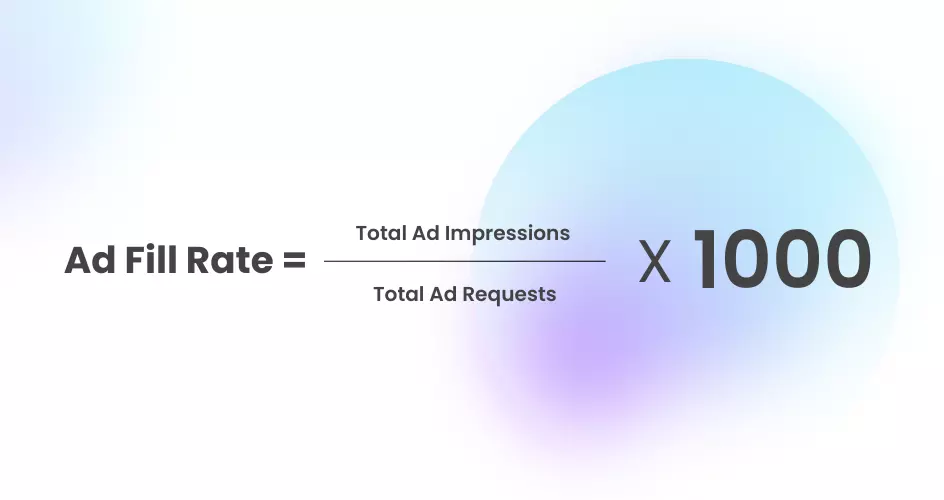In the current fast-paced digital era, online advertising has become a crucial aspect of the publishing industry. Publishers are always striving to monetize their content and increase their revenue streams. The aim here is to monetize every page view or impression at the best possible price. This is where the fill rate comes into existence.
Now, picture this: you have a powerful machine capable of producing impressive revenue, but it’s only working at half capacity. That’s what it’s like for publishers with a low ad fill rate. If you send 2 million ad requests and only receive 1 million impressions in return, you’re not utilizing your inventory to its full potential. In other words, you receive only 50% of the possible revenue you could get with a full salon.
Navigating the world of ad fill rate can be daunting, with its complex jargon and technicalities. That’s why this ultimate guide is here to demystify ad fill rates, highlight the importance, and provide effective strategies for optimization. So, if you’re a publisher looking to maximize your revenue streams, fasten your seatbelts, and get ready to maximize your revenue.
Table of Contents
What Is Ad Fill Rate?
Ad fill rate is a crucial metric for publishers that reflects the percentage of ad inventory filled with actual ads. It is the ratio between the number of ads delivered to the number of ads requested by the ad server.
A higher fill rate means more of the available ad spaces on a website are being occupied by ads, leading to better monetization. On the other hand, a lower fill rate indicates that many ad spaces remain empty or unfilled, which can negatively impact revenue generation.
Note: As much as the publisher wants all ad requests to be returned with an ad, advertisers want their ads to serve only the right audience at the right time.
How to Calculate Ad Fill Rate?
To calculate the ad fill rate, a publisher needs to know the number of ad requests they’ve made and the number of ad impressions they’ve received during a specific period. Ad requests refer to the number of times a website or app requests an ad, while ad impressions are the number of times an ad is actually displayed on the website or app.
Mathematically, the ad fill rate percentage is calculated by using the below formula:

To understand this better, let’s take a simple example. You put up 100 ad inventories on different pages of your website, and your fill rate is the percentage of ads you ‘actually display’ on the inventories. So, if you manage to display ads only on 85 ad inventories, then your fill rate is 85%.
Ad Fill Rate = (85 / 100) x 100% = 85%
It’s important to note that ad fill rate can vary depending on various factors, including the publisher’s website/app content, the type of ad formats used, and the ad network’s performance. So, it’s not easy to get a 100% fill rate all the time. That being said, you can consistently maintain your fill rate at 100 percent, provided you follow all the best practices. The fill rate helps publishers understand how their inventory is utilized and validate the market Demand.
100% Fill Rate – Is it Good Or Bad?
While a 100% ad fill rate may seem like the ideal scenario for publishers, it’s not necessarily a good or bad thing on its own. A 100% fill rate simply means that all the ad requests made by the publisher were filled with an ad.
A good fill rate conveys that the inventories are monetized well and have the right demand partners. So, ensuring your eCPM isn’t falling is also equally important. Some publishers compromise eCPM to fill their ad placements all the time. This isn’t commendable.
In fact, AdSense, the largest ad network, has a feature called ‘Ad Balance’ to set your fill rate. Let’s say you set the fill rate to 100; the AdSense algorithm will try its best to fill 100% of your impressions.
Similarly, when you set it to 60, it only fills your inventory up to 60%. But this time, it has the leverage of accepting only the highest-paying ads, as you just need 60 percent to show up. So, there’s no way you could say a 100% fill rate yields the best revenue unless you consider other factors, including eCPM, ad quality, and page load time.
Ideally, you should aim for both- a higher fill rate and a higher CPM. The fill-rate percentage point above which your CPM starts to plummet should be the threshold. Thus, optimizing to hit the threshold percent would yield the best results.
Note: The threshold value isn’t constant and varies based on seasonal factors.
Why Your Fill Rate Isn’t 100%?
We just said a 100% fill rate isn’t always good. But in some cases, the higher the fill rate, the higher the revenue. Every time you fail to get an ad for the pageview, you lose revenue. If you need to show an ad, regardless of how much it will pay you ($0.5 CPM or $5 CPM), you must get a 100 percent fill rate consistently.
There are a lot of concerning instances that make your ad request to return empty-handed.
Technical errors
Adtech is complex, and the supply chain is longer than you think. From ad fraud detection to ad verification to post-analytics, there are vendors all around the ad serving system to measure the effectiveness of the ad campaigns.
From the moment a user loads your page to the rendering of the ad, you can witness hundreds of events happening in milliseconds. This means you need to be technically strong and have an AdOps team to minimize the errors.
Lack of demand
Site owners believe it is easy for them to sell their ads one way or another. However, this is not possible with most ad networks because they do not have enough ads to fill your site.
69% of the top 10,000 sites have implemented header bidding as per the Header Bidding Industry Index by Kevel (Src).
Daisy-chaining multiple ad networks leads to increased load time or deprecated CPM. That’s why the publishers are shifting to header bidding solutions.
Compatibility
Some ads may not render on all browsers/devices/OS. The browser might be outdated; the format is not supported by the current version, etc., are some of the reasons.
Ensure you’re running the right mobile ad formats, as advertisers want to target users on mobile these days. The best way is to handpick the formats and ad sizes with exceeding demand.
Latency
Latency in Digital advertising can delay ad rendering and cause the user to leave the page before the ad appears. If your site continues to have the issue, demand partners would prefer to display ads on other sites but not on yours. This eventually leads to lower fill rates.
Reporting discrepancy
Ad servers count an ad impression when the ad request is sent to the demand partners, whereas the demand partners count the impression only when the ad is rendered to the user. This means you could see the discrepancy in fill rates, which costs you revenue.
Ad Blockers
Some ad blockers block ad networks instead of ad calls. Thus, allowing an ad request but preventing ad appearance. At the end of the day, you would see lower fill rates even though you’ve optimized everything.
What’s the solution?
There are many proven strategies to help you offset the lost revenue.
Average Ad Fill Rate
If the fill rate of a network is high, its eCPM will be lower than normal, thus explaining why most ad networks have a fill rate between 20-30%.
The prime means of boosting a website’s fill rate is through the use of a reputable advertising network with a wide selection of publishers. Many ad networks offer a fill rate of 25-50% which is not only unambitious but also creates difficulty in monetization. This may be because they have few advertisers and too many publishers, thus creating excess supply (publisher inventories) but insufficient demand (advertisers). Thus, providing the publisher with a lower fill rate.
If you wonder what your average ad fill rate should be, there is no standard answer you could refer to. We recommend implementing header bidding to capture as many demand partners as possible. This drastically increases your ad fill rate.
Ways to Maximize Your Fill Rate
You can maximize your fill rate by:
- Header Bidding
- Geo-targeting
- Flexible Ad Units
- Viewable Placements
If we’ve successfully whetted your appetite and you’re eager to dive straight into the strategies, we encourage you to check out our article on ‘How to Increase Your Ad Fill Rate’. Within the article, you’ll find a range of proven strategies and techniques that can help you optimize your ad fill rate and maximize your revenue potential.
It’s All About the Right Decision
Already tried the strategies but didn’t see much improvement? Well, it’s time to decide –
Optimizing your ad fill rate isn’t easy and often takes a lion-share of your time that could have been spent on other important tasks like writing killer content. So, you need a partner – Automatad.
Our team of experts specializes in programmatic ad solutions for publishers, providing proven strategies and advanced technologies to boost your revenue potential. Contact us today to learn more.
FAQs
Q1. What is Ad Fill Rate?
Ad fill rate is a metric used in the online advertising industry to measure the percentage of ad requests that are successfully filled with an ad.
Q2. What are the average fill rates with video ads?
The average fill rate for video ads can vary widely depending on several factors, such as the type of ad, the ad network used, and the publisher’s website or app. However, a typical range for video ad fill rates is around 60-80%.
Q3. How do I increase the ad fill rate?
There are several strategies that publishers can use to increase their ad fill rate, like optimizing ad placements, using multiple ad networks, improving content, and targeting the right audience. Other tactics may include adjusting ad formats and sizes, testing ad delivery settings, and using ad exchanges.























